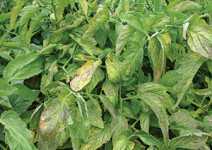Pest Of The Month: Tomato Chlorosis Virus

Tomato chlorosis virus (ToCV) is a relatively new disease in Florida that is being seen with increasing frequency in some areas. Detection can be difficult since the symptoms overlap abiotic symptoms of nutrient deficiency or herbicide phytotoxicity.
The leaves of plants infected with ToCV become yellow or purplish between the veins, stunted, and rolled. Onset of disease appears to occur during the short day-length period of late December through February. Symptoms are typically most apparent on middle to lower parts of plants, while new growth may appear normal. Lower leaves develop a progressive, interveinal chlorosis, often with necrotic flecking.
Symptoms resemble those caused by magnesium deficiency in tomato, but are less uniform within a leaflet or among leaflets on a leaf. As the disease progresses, interveinal necrosis can occur and the leaves become characteristically brittle, thick, and crisp. Fruit size and number appear reduced by virus infection.
Survival And Spread
ToCV is transmitted by whiteflies, including the banded wing whitefly (Trialeurodes abutilonea), greenhouse whitefly (T. vaporariorum), silverleaf whitefly (Bemisia tabaci biotype B), and sweetpotato whitefly (B. tabaci biotype A). The most efficient vector of ToCV is the silverleaf whitefly, which is present in Florida in abundance.
Transmission of ToCV is relatively efficient; whiteflies can transmit the virus with feeding times as short as an hour, but become more efficient the longer they are allowed to feed. The good news is that unlike tomato yellow leaf curl virus (TYLCV), in which case the virus can be transmitted for the length of the whitefly’s life (several weeks), ToCV can only be transmitted by a viruliferous whitefly for one to nine days.
Management
As with TYLCV, control of the virus vectors is an important strategy in ToCV management. The major way to reduce losses from criniviruses in tomato is insecticide-based control. Neonicitinoid-based products are most frequently used for whitefly control, and can be applied as a foliar spray, a seed treatment, or through drip application. While insecticides effectively reduce whitefly populations, such control methods are relatively inefficient for control of viruses, since whiteflies can transmit a virus before being killed by an insecticide. Unfortunately, most whitefly-transmitted criniviruses do not produce symptoms until three to four weeks after infection occurs. Therefore, infection can be widespread by the time symptoms are observed and control measures are implemented.
Growers can minimize exposure to ToCV by avoiding overlap with other susceptible crops. Avoid using infected transplants. Roguing of infected plants and general whitefly control may also help reduce virus spread.










